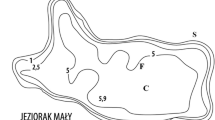Abstract
Lake Hula and its surrounding swamps were drained in the 1950s. Forty years later a draw down of groundwater table and peat soils degradation resulted in damage to agricultural crops and increase of nutrient fluxes to the down stream located Lake Kinneret. A reclamation project was implemented, including the construction of the new Lake Agmon wetlands. Agmon is utilised for drainage water removal and for eco-tourism. The ecology of Lake Agmon has been studied since 1994. Submerged macrophytes, started to grow in the lake during spring–summer and die-back in the fall. The maximal phosphorus stock in macrophytes tissues is similar to the phosphorus load in the lake water in fall when submerged vegetation decomposes. Most of the phosphorus load in the water during summer–fall is plant mediated phosphorus which is transferred from the sediments to the water by plants through uptake and incorporation during the onset of growth and released during die-back and decomposition. Summer phosphorus removal is crucial for Lake Kinnneret water quality protection, especially aimed at prevention of cyanobacteria blooms in summer. Macrophyte harvesting may reduce phosphorus stocks in lake Agmon serving as a manageable tool to improve water quality.
Similar content being viewed by others
References
Berger, D., 2002. Natural discharges of the upper Jordan in the Kinneret drainage basin. Special Report, Mekorot, Jordan District, Monitoring Unit. 17 p.(in Hebrew).
Davis, S. M., L. H. Gunderson, W. A. Park, J. R. Richardson & J. E. Mattson, 1997. Landscape dimension, composition and function in a changing Everglades Ecosystem. In Davis, S. M. & J. C. Ogden (eds), Everglades the Ecosystem and its Restoration. St. Lucie Press: 419–444.
Dimentman, C., H. J. Bromely & H. J. Por, 1992. Lake Hula. Israel Academy of Sciences and Humanities. 170 p.
Gophen, M. & D. Levanon (eds), 1995–2002. The Hula Project, Annual and semi annual reports (in Hebrew). MIGAL (Galilee Technological Center).
Gophen, M., 2000. Nutrient and Plant Dynamics in Lake Agmon Wetlands (Hula Valley, Israel): a review with emphasis on Typha domingensis (1994–1999). Hydrobiologia 441: 1–3.
Gophen, M., D. Kaplan, Y. Tsipris, M. Meron & I. Bar-Ilan, 2002. The newly created constructed wetlandecosystem of Lake Agmon (Hula Valley, Israel): functional perspectives. In Pries, J. (ed.), Treatment Wetlands for Water Quality Improvement, Quebec 2000 Conference Proceedings. CH2M Hill Canada Ltd.: 53–62.
Heidenreich, M. & A. Kleeberg, 2003. Phosphorus-binding in ironrich sediments of a shallow reservoir: spatial characterization based on sonar data. Hydrobiologia 506–509: 147–153.
Howell, T. A., D. W. Meek, C. J. Phene, R. L. Davis & R. L. Mc-Cormick, 1984. Automated weather data collection for research on irrigation scheduling. ASAE 27: 386–391.
Kaplan, D. & T. Niv, 1997-2002. Submerged Macrophytes in Lake Agmon. In Gophen, M. & D. Levanon (eds), Hula Project. Annual Report. pp. 85–96 [in Hebrew].
Kaplan, D., T. Oron & M. Gutman, 1998. Development of macrophytic vegetation in the Agnion wetland of Israel by spontaneous colonisation and reintroduction. Wetland Ecol. Manag. 6: 143–150.
Kesepeczki, É, D. Gál, P. Szabó & F. Pekár, 2003. Preliminary investigations on nutrient removal efficiency of a wetland-type ecosystem. Hydrobiologia 506–509: 665–670.
Markel, D., E. Sas, B. Lazar & A. Bein, 1996, 1997. Biogeochemistry. In: Gophen, M. & D. Levanon (eds), Hula Project. Annual Reports. pp. 194–213; 33–37 [in Hebrew].
Richardson, C. J., S. S. Cooper, R. G. Qian, R. G. Qualls, E. A. Romanowicz, R. J. Stevenson & P. Vaithiyanathan, 2000. Effects of phosphorus and hydroperiod alterations on ecosystem structure and functioning the Everglades. In C. J. Richardson (ed.), The Everglades Experiments (in press).
Rom, M., 1999. The Kinneret water catchment: trends and changes in nutrient contribution Mekorot, national Water supply co. Water catchment unit, Jordan District. Special Report: 63 p. [in Hebrew].
Søndergaard, M. J. P. Jensen & E. Jeppesen, 2003. Role of sediment and internal loading of phosphorus in shallow lakes. Hydrobiologia 506–509: 135–145.
Tsipris, Y., M. Meron & Y. Poker, 1996–2001. Water Table measurements in the Hula Project. In Gophen, M. (ed.), Annual Reports of Hula Project [in Hebrew].
Tsipris, Y., M. Meron, Y. Poker & E. Yasur, 1998. Water table measurements in the Hula Project. Wetland Ecol. Manag. 6: 124–131.
Author information
Authors and Affiliations
Rights and permissions
About this article
Cite this article
Gophen, M., Tsipris, Y., Meron, M. et al. The management of Lake Agmon Wetlands (Hula Valley, Israel). Hydrobiologia 506, 803–809 (2003). https://doi.org/10.1023/B:HYDR.0000008602.77264.8c
Published:
Issue Date:
DOI: https://doi.org/10.1023/B:HYDR.0000008602.77264.8c




